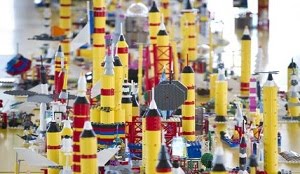My flight aboard the 'vomit comet'
Martin Redfern experiences near-weightlessness.
The European Space Agency (Esa) has just completed its 50th parabolic flight campaign out of Bordeaux International Airport.
BBC science producer Martin Redfern joined scientists aboard the Airbus Zero G plane to see their research and share their experience.
Astronauts in orbit on the International Space Station (ISS) experience weightlessness all the time. Nearer the ground it is much harder to achieve that even for a few seconds.
 Early attempts involved dropping experiments from a fire escape or down the lift shaft. Aircraft can do a little better, providing 20 seconds or so of weightlessness at a time.
Early attempts involved dropping experiments from a fire escape or down the lift shaft. Aircraft can do a little better, providing 20 seconds or so of weightlessness at a time.The first experiments were performed in the US on what was known as the "vomit comet" - though motion-sickness medication has improved a little since then.
Esa now uses the largest plane flying such parabolic flights in the world, an Airbus A300.
It is the oldest Airbus still flying, but, as one of the prototypes, has never seen commercial service and is low mileage. It is operated by the French company Novespace, under their chief executive, European astronaut Jean-Francois Clervoy.
He told BBC News: "The microgravity we provide in this service is exactly the same as that experienced by astronauts in the space station. But it doesn't last very long, it only lasts 22 seconds."
What's the angle?
You don't have to fly high to generate weightlessness. Zero G cruises at 6,000m (20,000ft) and the captain counts down to the pull up.
That's when you pay for your subsequent weight loss. He pulls back his control stick and increases the thrust, subjecting the passengers to about 1.8 G ("G" being the unit of measure for g-force), nearly doubling their apparent weight.
The plane angles up and the captain calls out the angle: "20 … 30 … 40." At 47 degrees, he announces "injection" and cuts the engines. Almost instantly you lose your weight and, if not strapped down or holding on, slowly rise into the air.
For those of us on our first flight, it's a completely new sensation. It's surprisingly hard, at first, to control or even to work out which way up you are.
The instinctive response is to kick out with feet and hands as you might under water. But there is no water to swim against and it is easy to end up at a strange angle near the ceiling.
But you don't have long to work out where the ground is. Just 22 seconds later, as the captain announces "pull out", you're attracted back down towards it with 1.8 times your normal weight. 
Fortunately, there are other chances to get used to it. Each flight includes 31 such parabolas, in surprisingly quick succession.
By the end, if you're not still working on an experiment and if you haven't been sick, Esa flight coordinator Vladimir Pletzer will spin you round in mid-air a few times. The record is about 16 over a 20-second period, a record your reporter did not attempt to break.
Scientific aims
It is the experience of a lifetime and there are plans to offer parabolic flights in Europe in addition to those already available in the US and Russia for fare-paying, would-be space tourists.
Jean-Francois Clervoy says: "For a cost of around 4,000 to 5,000 euros (£3,400-£4,300; $5,700-$7,000) we could offer 15 parabolas, and on some of those we could provide lunar gravity and Mars gravity before we go to zero-g, so you could experience standing on the Moon, standing on Mars and the true weightlessness of space."
But the purpose of the Esa flights is scientific. On board for the three days of flying in this 50th campaign there were 14 different experiments from across Europe.
Some were testing equipment that will soon fly on the ISS. Some had human subjects, monitoring brainwaves, cardiac output or visual perception. Others were looking at materials science, such as boiling droplets, vibrating granules, bubble formation or convection.
The largest experiment had a huge power supply for vaporising metallic samples to reveal the basic properties of alloys and design better catalysts for fuel cells and coatings for turbine blades.
One thing was noticeably absent: British involvement. The UK does not subscribe to that aspect of Esa's work so British scientists cannot compete for a place aboard Zero G.
But that could be about to change. During the campaign, talks were under way to explore the possibility of the Airbus Zero G providing a campaign for UK scientists, perhaps even from a British airfield.
As a result, the British National Space Centre (BNSC) has set up a website to gauge interest. Together with the recent selection by Esa of the British astronaut Timothy Peake, it might signify the beginnings of a UK human spaceflight programme.




0 comments:
Post a Comment